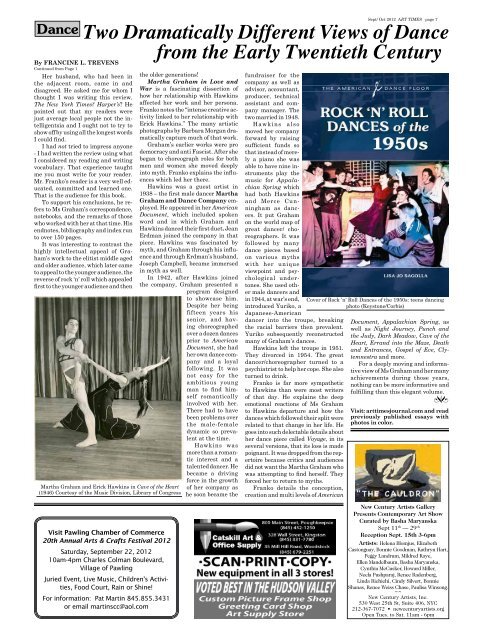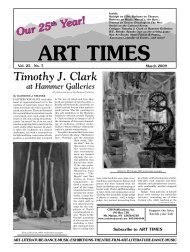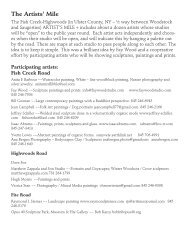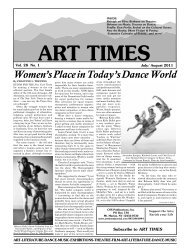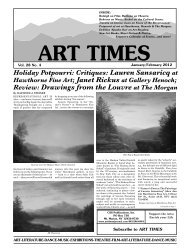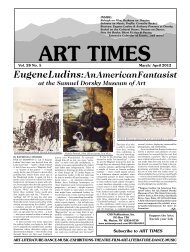September/ October 2012 - Art Times
September/ October 2012 - Art Times
September/ October 2012 - Art Times
Create successful ePaper yourself
Turn your PDF publications into a flip-book with our unique Google optimized e-Paper software.
Dance<br />
By Francine L. Trevens<br />
Continued from Page 1<br />
Sept/ Oct <strong>2012</strong> ART TIMES page 7<br />
Two Dramatically Different Views of Dance<br />
from the Early Twentieth Century<br />
Her husband, who had been in<br />
the adjacent room, came in and<br />
disagreed. He asked me for whom I<br />
thought I was writing this review.<br />
The New York <strong>Times</strong>? Harper’s? He<br />
pointed out that my readers were<br />
just average local people not the intelligentsia<br />
and I ought not to try to<br />
show off by using all the longest words<br />
I could find.<br />
I had not tried to impress anyone<br />
- I had written the review using what<br />
I considered my reading and writing<br />
vocabulary. That experience taught<br />
me you must write for your reader.<br />
Mr. Franko’s reader is a very well educated,<br />
committed and learned one.<br />
That is the audience for this book.<br />
To support his conclusions, he refers<br />
to Ms Graham’s correspondence,<br />
notebooks, and the remarks of those<br />
who worked with her at that time. His<br />
endnotes, bibliography and index run<br />
to over 150 pages.<br />
It was interesting to contrast the<br />
highly intellectual appeal of Graham’s<br />
work to the elitist middle aged<br />
and older audience, which later came<br />
to appeal to the younger audience, the<br />
reverse of rock ‘n’ roll which appealed<br />
first to the younger audience and then<br />
Martha Graham and Erick Hawkins in Cave of the Heart<br />
(1946) Courtesy of the Music Division, Library of Congress<br />
the older generations!<br />
Martha Graham in Love and<br />
War is a fascinating dissection of<br />
how her relationship with Hawkins<br />
affected her work and her persona.<br />
Franko notes the “intense creative activity<br />
linked to her relationship with<br />
Erick Hawkins.” The many artistic<br />
photographs by Barbara Morgan dramatically<br />
capture much of that work.<br />
Graham’s earlier works were pro<br />
democracy and anti Fascist. After she<br />
began to choreograph roles for both<br />
men and women she moved deeply<br />
into myth. Franko explains the influences<br />
which led her there.<br />
Hawkins was a guest artist in<br />
1938 – the first male dancer Martha<br />
Graham and Dance Company employed.<br />
He appeared in her American<br />
Document, which included spoken<br />
word and in which Graham and<br />
Hawkins danced their first duet. Jean<br />
Erdman joined the company in that<br />
piece. Hawkins was fascinated by<br />
myth, and Graham through his influence<br />
and through Erdman’s husband,<br />
Joseph Campbell, became immersed<br />
in myth as well.<br />
In 1942, after Hawkins joined<br />
the company, Graham presented a<br />
program designed<br />
to showcase him.<br />
Despite her being<br />
fifteen years his<br />
senior, and having<br />
choreographed<br />
over a dozen dances<br />
prior to American<br />
Document, she had<br />
her own dance company<br />
and a loyal<br />
following. It was<br />
not easy for the<br />
ambitious young<br />
man to find himself<br />
romantically<br />
involved with her.<br />
There had to have<br />
been problems over<br />
the male-female<br />
dynamic so prevalent<br />
at the time.<br />
Hawkins was<br />
more than a romantic<br />
interest and a<br />
talented dancer. He<br />
became a driving<br />
force in the growth<br />
of her company as<br />
he soon became the<br />
fundraiser for the<br />
company as well as<br />
advisor, accountant,<br />
producer, technical<br />
assistant and company<br />
manager. The<br />
two married in 1948.<br />
Hawkins also<br />
moved her company<br />
forward by raising<br />
sufficient funds so<br />
that instead of merely<br />
a piano she was<br />
able to have nine instruments<br />
play the<br />
music for Appalachian<br />
Spring which<br />
had both Hawkins<br />
and Merce Cunningham<br />
as dancers.<br />
It put Graham<br />
on the world map of<br />
great dancer/ choreographers.<br />
It was<br />
followed by many<br />
dance pieces based<br />
on various myths<br />
with her unique<br />
viewpoint and psychological<br />
undertones.<br />
She used other<br />
male dancers and<br />
in 1944, at war’s end,<br />
introduced Yuriko, a<br />
Japanese-American<br />
dancer into the troupe, breaking<br />
the racial barriers then prevalent.<br />
Yuriko subsequently reconstructed<br />
many of Graham’s dances.<br />
Hawkins left the troupe in 1951.<br />
They divorced in 1954. The great<br />
dancer/choreographer turned to a<br />
psychiatrist to help her cope. She also<br />
turned to drink.<br />
Franko is far more sympathetic<br />
to Hawkins than were most writers<br />
of that day. He explains the deep<br />
emotional reactions of Ms Graham<br />
to Hawkins departure and how the<br />
dances which followed their split were<br />
related to that change in her life. He<br />
goes into such delectable details about<br />
her dance piece called Voyage, in its<br />
several versions, that its loss is made<br />
poignant. It was dropped from the repertoire<br />
because critics and audiences<br />
did not want the Martha Graham who<br />
was attempting to find herself. They<br />
forced her to return to myths.<br />
Franko details the conception,<br />
creation and multi levels of American<br />
Cover of Rock ’n’ Roll Dances of the 1950s: teens dancing<br />
photo (Keystone/Corbis)<br />
Document, Appalachian Spring, as<br />
well as Night Journey, Punch and<br />
the Judy, Dark Meadow, Cave of the<br />
Heart, Errand into the Maze, Death<br />
and Entrances, Gospel of Eve, Clytemnestra<br />
and more.<br />
For a deeply moving and informative<br />
view of Ms Graham and her many<br />
achievements during those years,<br />
nothing can be more informative and<br />
fulfilling than this elegant volume.<br />
ef<br />
Visit: arttimesjournal.com and read<br />
previously published essays with<br />
photos in color.<br />
Visit Pawling Chamber of Commerce<br />
20th Annual <strong>Art</strong>s & Crafts Festival <strong>2012</strong><br />
Saturday, <strong>September</strong> 22, <strong>2012</strong><br />
10am-4pm Charles Colman Boulevard,<br />
Village of Pawling<br />
Juried Event, Live Music, Children's Activities,<br />
Food Court, Rain or Shine!<br />
For information: Pat Martin 845.855.3431<br />
or email martinscc@aol.com<br />
New Century <strong>Art</strong>ists Gallery<br />
Presents Contemporary <strong>Art</strong> Show<br />
Curated by Basha Maryanska<br />
Sept 11 th — 29 th<br />
Reception Sept. 15th 3-6pm<br />
<strong>Art</strong>ists: Helena Blomjus, Elizabeth<br />
Castonguay, Bonnie Goodman, Kathryn Hart,<br />
Peggy Landrum, Mildred Kaye,<br />
Ellen Mandelbaum, Basha Maryanska,<br />
Cynthia McCusker, Howard Miller,<br />
Neela Pushparaj, Renee Radenberg,<br />
Linda Richichi, Cindy Silvert, Bonnie<br />
Shanas, Renee Weiss Chase, Paulisa Winsong.<br />
~~<br />
New Century <strong>Art</strong>ists, Inc.<br />
530 West 25th St, Suite 406, NYC<br />
212-367-7072 • newcenturyartists.org<br />
Open Tues. to Sat. 11am - 6pm


